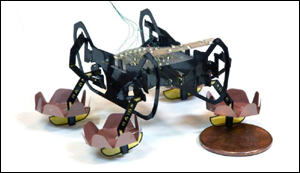Next-generation robotic cockroach can explore underwater environments
3. 7. 2018 | SEAS | www.seas.harvard.edu
In nature, cockroaches can survive underwater for up to 30 minutes. Now, a robotic cockroach can do even better. Harvard’s Ambulatory Microrobot, known as HAMR, can walk on land, swim on the surface of water, and walk underwater for as long as necessary, opening up new environments for this little bot to explore.
This next generation HAMR uses multifunctional foot pads that rely on surface tension and surface tension induced buoyancy when HAMR needs to swim but can also apply a voltage to break the water surface when HAMR needs to sink.

Moving on the surface of water allows a microrobot to evade submerged obstacles and reduces drag. Using four pairs of asymmetric flaps and custom designed swimming gaits, HAMR robo-paddles on the water surface to swim. Exploiting the unsteady interaction between the robot’s passive flaps and the surrounding water, the robot generates swimming gaits similar to that of a diving beetle. This allows the robot to effectively swim forward and turn.
Read more at SEAS
Image Credit: Harvard University
-jk-




